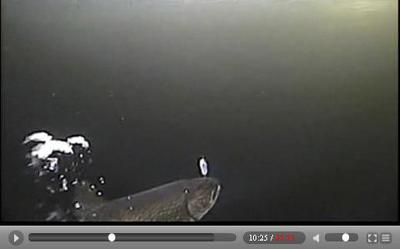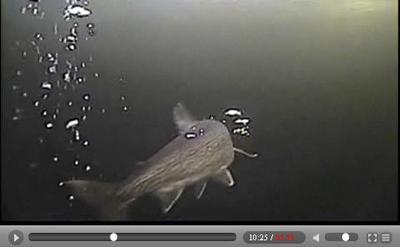I just watched the Lake of the woods episode with lake trout and I can’t remember the name of the flutter spoon they were using,anyone know ?
Posts: 1
IDO » Forums » Fishing Forums » Ice Fishing Forum » Name of ice spoon from Lake of the woods episode
I just watched the Lake of the woods episode with lake trout and I can’t remember the name of the flutter spoon they were using,anyone know ?
Welcome to IDO- Yes that was the slender spoon- That is a great spoon that you will hear great things about because of it’s action- I have many different sizes/colors in my ice boxes. I think my favorite color would be silver/glow-
Here is where you can order
Custom Jigs Website
Welcome Z..and love your handle!!
Btw all the IDO Tv show are viewable on our website.
If you need them for future reference. 
I sure wish Gander would carry the Slender Spoon. I was really interested in buying some to try out until I found you can’t get them in the stores around here 
I don’t order on-line since I do NOT have any credit cards to do so with. If I can’t get it in the store I guess I don’t need it 

Quote:
I sure wish Gander would carry the Slender Spoon. I was really interested in buying some to try out until I found you can’t get them in the stores around here
I don’t order on-line since I do NOT have any credit cards to do so with. If I can’t get it in the store I guess I don’t need it

Mike,
Call them and place an order over the phone or ask them
to e-mail you an order form. 800 831-5535
Then send them a check or money order or ask them about
shipping C.O.D.
No credit card required.
Quote:
I have a question. I know that if you bring a walleye up from the depths in the river,Alot of them die off. Sounds like these fish were anywere from 20-80FOW. Do a majority of thse fish live after release?
Interesting question! I would like to know the answer to this question as well.
FDR
Quote:
I have a question. I know that if you bring a walleye up from the depths in the river,Alot of them die off. Sounds like these fish were anywere from 20-80FOW. Do a majority of thse fish live after release?
Yes they do survive. Unlike walleye, lake trout have the ability to regulate the gasses in their swim bladder by venting a build up of gasses out of their mouth.
During the filming of this particular episode Scott did catch a walleye. I believe that fish came suspended out over 90 feet of water and that fish was reduced to possession as it was quite literally dead before it hit the surface. The lakers on the other hand, because they can regulate their swim bladders in the way described above, swim off after the fight without issue.
By the way… Great question!
If you go back and watch the episode here online you’ll actually be able to see the laker “burp” multiple times as it fights below the hole. You can find that footage at 15:50 of the video as we go out to commercial.
I’ve also added a couple photos from that section of video where you can see the laker cutting loose with a big ‘urp.
http://www.idofishing.com/videos/viewvid.php/Number/720838/ontario-lake-trout


I remember reading about how the trout were able to tolerate coming from deep water better than most other fresh water fish. But it is good to have that clarified 

two questions,
first so the only way to get the slender spoon is to order it online right. I live in the twin cities and would like to get some.
second, so if I pull a walleye from about 20ft of water it would die. does that apply to many other fishes too.
Those Lake Trout are quite amazing. I have had them come from 80 feet of water and chase my 5 inch tube too 10 feet under the ice as fast as you can real up. Then they would slam it hard. They are really fun to catch. It can be long days though. Just like what was said on the video if you locate bait fish sit tight the trout will find you. My favorite lure was a 5 inch salt and pepper tube with a light tube jig with a big barbless hook. There are some lakes in Minnesota that are opened to winter Lake Trout fishing, check out the regulations. 
Quote:
first so the only way to get the slender spoon is to order it online right
I would bet you can find some in the Cities. Our local Gander does not carry them, but I am sure other ones do.
Quote:
so if I pull a walleye from about 20ft of water it would die
Not likely, but from 30 fow there is a strong likelyhood that they will die. Sometimes I have had the air bladder come out from walleye in 25 fow.
I have had to keep a couple due to the swim bladder expanding. However, I’ve always been told that if you bring them up slow it can prevent this problem. Is there any truth to this??
Quote:
so how would you know when their air bladder come out.
From the South Dakota Fisheries website at: http://www.sdgfp.info/Wildlife/Fishing/Info/FAQ.htm#deep
Generally, fish caught from depths 30 feet or greater should be considered as coming from deep water. From this depth, as fish are brought to the surface, the gases in their air bladder begin to expand placing pressure on their internal organs. The air bladder in some fish will be so expanded that it will cause their internal organs to extend out of the mouth. These fish are unable to swim beneath the surface. While other fish you may release after catching them from this depth appear to be O.K., often the internal damage caused to their other organs will take several hours or days to kill them.
Quote:
what other fish does this apply to. this is really important to me because I would not want to fish for a walleye and release it knowing it will just die.
Perch, walleye, crappies… panfish. Fish suffering from rapid decompression are easy to spot. Their abdomen is swollen, eyes are bulged from the surface of the head and often their stomach protrudes from the fishes’ mouth. When a release attempt is made the fish is unable to swim beneath the surface of the water.
Quote:
I have had to keep a couple due to the swim bladder expanding. However, I’ve always been told that if you bring them up slow it can prevent this problem. Is there any truth to this??
This is indeed truthful… but not practical. An angler would need to allow a lot of time for a fish to be brought slowly to the surface to keep from giving the fish the bends. Adding a few extra seconds or minutes is not going to do…. anything. For comparison, look at how long divers need to spend decompressing from deep dives. They need to spend extended amounts of time slowly returning to the surface.
Quote:
suffering from rapid decompression are easy to spot. Their abdomen is swollen, eyes are bulged from the surface of the head and often their stomach protrudes from the fishes’ mouth. When a release attempt is made the fish is unable to swim beneath the surface of the water.
Sounds like me after the belly buster buffett 
When scuba diving, in depths over 100′, we did safety stops, which were really just drift dives, after every 30′ of ascend. The final safety stop is 10′ under the surface for 5 minutes. Doing the math, we did 15 minutes of safety depth stops for 100′ of depth. It’s unreal the amount of pressure, the body feels on the way down. Until you do it, you really can’t explain it.
big G
From my experience the way fish react to being caught from deep water varies greatly from one fish to the next. On the river I can catch fish from 28′ of water that show no signs of a problem and then the next fish caught in 25 feet of water all but explodes due to the pressure change. I’ve witnessed this scenario in my boat on a number of occasions and it it leaves me scratching my head each time. Why one and not the other that came from deeper water?
But I digress. There’s a number of deep water mortality studies out there to read but to my knowledge none of them are citing mortality rates anywhere near 50%. If someone has any new info to share regarding a deep water mortality study, please share it.
I found this and thought I would share:
Should I reel in fish hooked in deep water quickly or slowly?
Fast! Contrary to popular belief, slowly reeling in a fish from deep water DOES NOT give a fish enough time to compensate for the change in pressure. Between 20 and 30 minutes may be needed for a fish to compensate for pressure differences between a depth of 30 ft and the surface. Instead, prolonging the time it takes to land and release a fish, increases its stress level. The tissues around the gas bladder are often capable of preventing the gas bladder from increasing in size for up to 5 minutes after the pressure outside of the fish decreases. Once a fish is in the boat, or on the ice, release it as quickly as possible to maximize its chance of surviving. The colder the water the better, especially surface temp.
It also states that bringing a fish from 60′ has a 50% chance off survival and from 30′ the chance of survial increases greatly.
Nate
“Lets ASSUME that 50% died” ……
sorry, misread the SD link…was very much hoping this wasn’t the mortality rate. Thanks Nate and James for the info, it had me worried for a bit.
I believe the MN DNR was working on a deep water mortality study on river walleye and sauger. I’ll see if I can come up with any results from that study as well.
This is a very interesting and worthwhile topic. 
I’ve caught fish in the Missouri river that were more than 30′ deep and we had to keep them all. The belly was protruding into the mouth on them all. This was back in the day when we knifed everything tho so it wasn’t a big deal to us. 



Quote:
We took a lot of care with the Lake Trout in that show to make sure they survived, as some were as old as James
I would guess

Hey… now why you got to go and be like that?! 
We fish perch on Mendota here in 70 to 80 feet of water. I keep everything that I pull up but the camera once showed me that others do not when I dropped the camera down in a few community spots the small perch that had been released were all dead just below the ice. I put tip ups there with dead bait and caught my best pike ever.
Quote:
as some were as old as James. I would guess
I wouldn’t have guessed that fish can get that old. You learn something everyday. 
You must be logged in to reply to this topic.